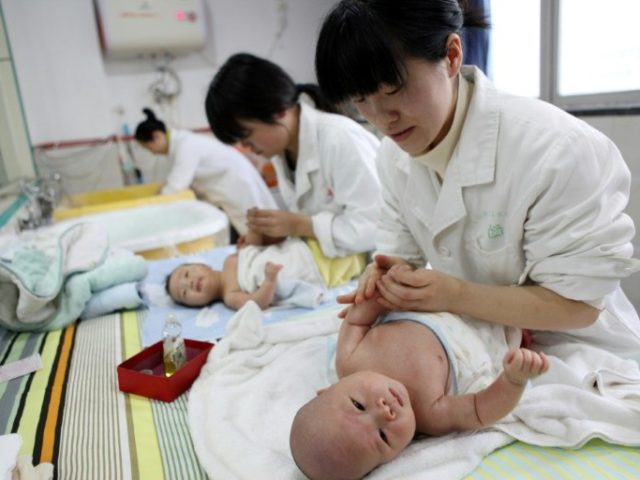China’s state-run Global Times newspaper reported Friday that, in a stunning walkback of its decades-long policy of forced abortions, at least one province in China has begun restricting women’s access to abortions by demanding the approval of three medical professionals.
China implemented a “one-child policy” in 1971, forcibly sterilizing millions of women and forcing hundreds of millions of others to undergo abortions. As sons are highly valued in Chinese culture, many families chose to abort every time an unborn child was found to be a daughter, triggering a gross gender imbalance in the national population that has now made it extremely difficult for many Chinese men to find a wife. A Washington Post analysis in May noted that there are 34 million fewer women in China than men.
In 2016, Communist Party chief Xi Jinping ordered the loosening of the rule, imposing a “two-child policy” in hopes that people would embrace the ability to have a bigger family. Birth rates have not significantly spiked, however, leading to rumors that China may completely do away with restricting the number of children a family can have.
Jiangxi Province appears to have taken the first step in this measure, limiting the ease with which families can access abortions.
“The province’s Health and Family Planning Commission issued a notice recently saying that women who are pregnant for more than 14 weeks must have the signed approval of three medical professionals confirming that an abortion is medically necessary before any procedure,” the Global Times reports. While the women would not be allowed to keep a third child by law, they would no longer be able to abort a daughter in the hopes of next time conceiving a son.
Chinese government experts claim the move is necessary to “protect a pregnant woman’s health and safety, because getting an abortion after 14 weeks is dangerous.”
According to the Global Times, China witnesses 13 million abortions a year, not including “those who use abortion pills or illegal clinics.” Studies by independent monitors suggest the real number is closer to 23 million abortions a year, many forced by the government to ensure adherence to the two-child policy.
In total, the Chinese Health Ministry revealed in 2013 that the one-child policy resulted in more than 336 million abortions and 196 million sterilizations of men and women since 1971. There is no way to know how many of these were by choice versus government coercion.
China replaced its one-child policy with a two-child policy in 2016, noting that the economy was suffering from too few individuals in the workforce and even lower than preferred birth rates due to the disproportionate surplus of men compared to the female population. China’s National Commission of Health and Family Planning predicted 20 million new births in 2017. Chinese families fell far short of that – only 17.2 babies were born in 2017, a decline from the year before when the one-child policy was still in effect. Studies following the implementation of the policy also unveiled that government officials continue to impose “heavy fines, job termination, arbitrary detention, and coerced abortion” on couples who do not comply.
Chinese culture pressures couples to have sons, a reality that the Global Times admitted to in a 2016 article on foreigners having mixed children in China.
“Gender selection used to be common in China during the years after a strict family planning policy was introduced in 1979, which limited urban couples to one child. However, the enactment of the two-child policy in October 2015 has heralded a change in the social psyche,” the Times claimed. The article found that the implementation of the two-child policy, rather than reducing pressure to have a son, increased family pressure to have both a daughter and a son and triggered a significant spike in the purchasing of gender testing.
China’s initial solution to the declining birth rate and killing of baby girls was to begin fining doctors and “organizations that conduct medically inessential prenatal sex discernment or sex-selective abortions” and banning them from providing abortions again. “The revision to the law aims to tackle China’s high gender imbalance, a direct result of pre-birth sex discernment and sex-selective abortions driven by cultural preference for sons.”
In May, rumors began to surface that China would do away with regulating birth rates completely. The two-child policy experience suggests that decades of communist indoctrination has made the population accustomed to aborting children they do not want and that the decline in birth rate may not end soon.
Chinese state media still applaud the one-child policy. While rumors circulated of a complete end to limiting the number of children families could have, the Global Times published a story in May asserting that, without the one-child policy, Chinese women would have been forced to become “breeding machines” for the nation.

COMMENTS
Please let us know if you're having issues with commenting.